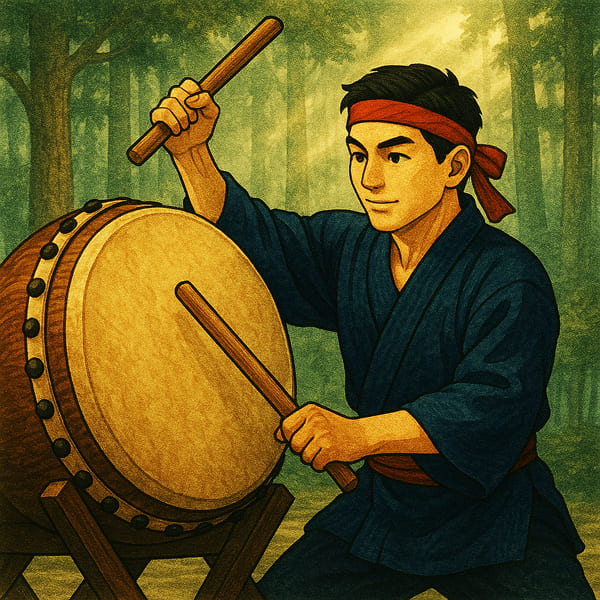Wadaiko: The Heartbeat of Japanese Traditional Drumming

Feel the earth shake. Hear the echo in your chest. See the power in every strike.
This is wadaiko—the thundering art of traditional Japanese drumming.
Far more than just percussion, wadaiko is a breathtaking blend of rhythm, strength, and spirit. With roots in ancient rituals and the sounds of war, these powerful drums now command stages and festivals across Japan and the world.
Step into the heart-pounding world of wadaiko—where every beat tells a story, and every performance awakens the soul.
The Ancient Roots and History of Wadaiko Drums
The origin of wadaiko traces back thousands of years, with some evidence suggesting its use as early as the Jōmon period (c. 14,000–300 BCE). Archaeological discoveries of drum-shaped clay artifacts and ancient cave dwellings hint at a deep-rooted musical culture even in prehistoric Japan. Over time, drums took on important roles in religious ceremonies, harvest rituals, and even in mythological tales, as recorded in classical texts like the Kojiki and Nihon Shoki.
In ancient Japan, the resonant beat of drums was believed to bridge the human and spiritual realms, summoning gods and carrying prayers skyward. On the battlefield, large war drums called jindaiko were used to rally warriors and intimidate enemies. Over the centuries, wadaiko evolved from sacred and martial uses into a vibrant part of festivals (matsuri), temple rituals, and community celebrations throughout Japan.
Types of Wadaiko and Their Unique Sounds
Wadaiko encompasses various types of drums, each with its distinct construction and sound:
- Nagado-daiko
The most iconic drum, featuring a long wooden body and cowhide heads on both sides. It produces deep, resonant tones and is played vertically (tate-uchi) or horizontally (yoko-uchi). - Shime-daiko
A small, tightly-stretched drum with a crisp, high-pitched sound. Often used in ensemble settings for timing and rhythm. - Okedo-daiko
Barrel-shaped and rope-tensioned, this lighter drum is ideal for mobile performances and stage shows. Its bright, sharp tone adds clarity and contrast in group arrangements.
Wadaiko performances are as much visual art as music. Drummers incorporate dramatic body movements and synchronized group choreography, turning each performance into a rhythmic spectacle.
A small break — a little side note
Wadaiko, or traditional Japanese drums, may look simple—but their sound is anything but. With every thunderous beat, they deliver a deep, resonant energy that stirs the soul.
As a longtime drummer, I’m always struck by how wadaiko performers pour their whole being into each strike. It’s not just rhythm—it’s emotion in motion, felt as much as heard.
Watch the video below to witness a masterful performance by top-level wadaiko artists—and feel the sound that shakes not just the air, but the soul.
Cultural Importance of Wadaiko in Japan
In Japan, wadaiko is not just performed—it is lived. From childhood school programs to village festivals and national ceremonies, these drums are woven into the rhythm of everyday life.
Some Japanese children grow up learning wadaiko as part of school or community groups, where they develop not only musical skills but also discipline, teamwork, and a sense of shared cultural identity. For many rural communities, local taiko ensembles serve as vital threads that connect generations, preserve tradition, and foster unity.
At Shinto shrines and Buddhist temples, wadaiko accompanies seasonal rituals and sacred dances, marking the passage of time with powerful, ceremonial beats. In modern cities, it has also found new life on international stages, blending traditional forms with contemporary expression.
Whether echoing through mountaintop festivals or reverberating in global concert halls, wadaiko continues to carry the heartbeat of Japan into the future.
Wadaiko’s Global Reach and Modern Influence
In recent decades, wadaiko has gained international recognition, with taiko groups flourishing in North America, Europe, and beyond. While maintaining traditional roots, many artists have blended wadaiko with jazz, rock, and world music, creating cross-cultural expressions.
Workshops and live taiko drumming performances now attract global audiences eager to experience this dramatic and deeply moving art form. For those interested in cultural tourism, attending a wadaiko performance is one of the best ways to connect with the soul of Japan.
A small break — a little side note
Experience the raw power and precision of Kodo, Japan’s world-renowned taiko ensemble, in this full-length performance of “Zoku”.
Combining thunderous drumming, masterful choreography, and moments of quiet intensity, Kodo brings the spirit of traditional Japanese rhythm to the global stage.
Whether you're discovering wadaiko for the first time or already captivated by its sound, this performance offers a thrilling window into the artistry, energy, and soul of Japanese drumming.
Final Thoughts: Experience the Spirit of Wadaiko
Wadaiko is more than music—it’s a force of nature.
With every beat, it echoes the rhythm of Japan’s spirit, shaped by centuries of tradition, celebration, and devotion.
Whether born from ancient rituals, carried through village festivals, or reimagined on global stages, wadaiko continues to inspire and connect.
If you ever get the chance, don’t just listen—feel it in person.
Attend a live wadaiko performance, stand close, and let the drums speak to you.
In that moment, you won’t just be hearing Japan’s past—you’ll be feeling its soul.